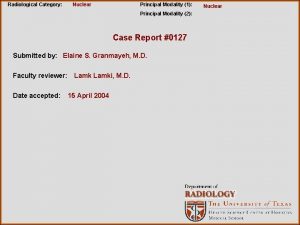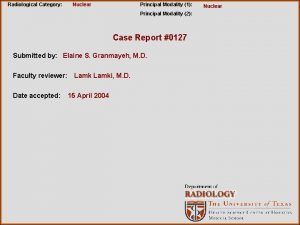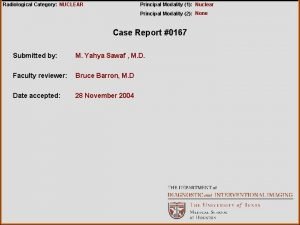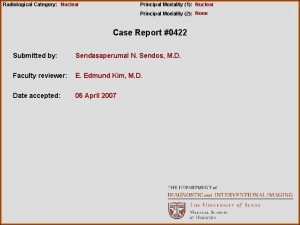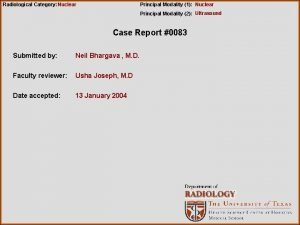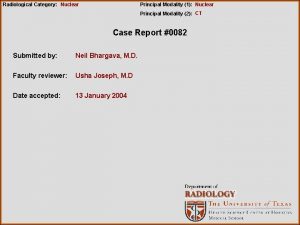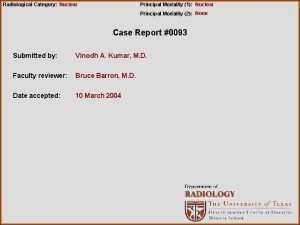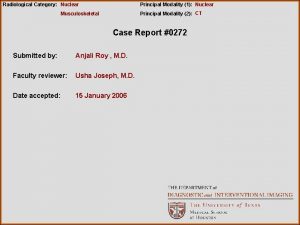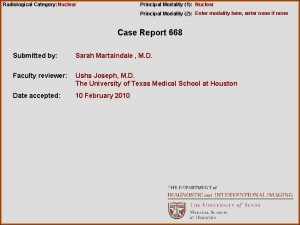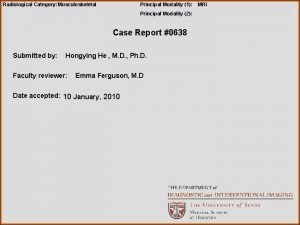Radiological Category Nuclear Principal Modality 1 Nuclear Principal













- Slides: 13

Radiological Category: Nuclear Principal Modality (1): Nuclear Principal Modality (2): CT Musculoskeletal Case Report #0272 Submitted by: Anjali Roy , M. D. Faculty reviewer: Usha Joseph, M. D. Date accepted: 15 January 2006

Case History 56 year old male with hemoptysis, 30 lb unexplained weight loss and pain in both legs.

Radiological Presentations

Radiological Presentations

Radiological Presentations

Test Your Diagnosis Which one of the following is your choice for the appropriate diagnosis? After your selection, go to next page. • Chronic venous insufficiency. • Hyperthyroidism (Thyroid acropachy). • Paget’s disease. • Primary hypertrophic osteoarthropathy. • Hypertrophic pulmonary osteoathropathy. • Acromegaly. • Endosteal hyperostosis (Van Buchem’s disease). • Metastases.

Findings and Differentials Findings: Tc 99 m MDP bone scan: Diffusely increased radiotracer uptake along the cortical margins of tibiae, fibulae, radii, ulnae and femora with a “tram track” appearance. CT scan: Large cavitary lesion in right upper lobe with debris and air fluid level and adjacent air space opacities. Differentials: • Hypertrophic pulmonary osteoarthropathy. • Venous stasis/ Chronic venous insufficiency. • Hyperthyroidism.

Discussion Hypertrophic osteoarthropathy (HOA), also known as pachydermoperiostosis, is a clinical syndrome of clubbing of the fingers and toes, enlargement of the extremities, and painful swollen joints. HOA is characterized by symmetric periostitis usually involving the diaphysis and metaphysis of long bones. HOA can be primary or secondary. The primary form is a rare autosomal dominant condition. The secondary form is known as HPOA or Hypertrophic Pulmonary Osteoarthropathy. Although the cause is usually related to a pulmonary process, this is not true 100% of the time. It is thought to be due to the release or lack of breakdown of vasodilating substances in the lung, AV fistulas in abnormal lung, neurogenic vasodilatation (vagus) or via hormonal pathways (growth hormone and others). The disease presents as pain and swelling of the limbs and joints with stiffness. Clubbing is very common and is thought to be part of the spectrum of HPOA. Peripheral neurovascular disturbance such as flushing and blanching, sweating, erythema, and hypertrophy can also occur. Although the mediating factor is uncertain, the periosteal bone formation often regresses after removal of the lung cancer and is again seen with recurrent disease.

Discussion Radiologic findings: Diametaphyseal areas of long bones are mostly affected, most commonly the radius and ulna (80%), but also the tibia and fibula (75%), proximal phalanges (60%), femur (50%, as in this case), and other sites, usually in the extremities. • Bone scan findings occur before plain film findings and shows symmetric, diffuse increased uptake along the cortical margins of tubular long bones in the metaphyses and diaphyses. Some irregularity may be present. Periarticular involvement is due to synovitis, the scapula is affected in 2/3 rds of cases, the mandible and maxilla in 40%. • On plain film, there is periosteal reaction in the sites described, smooth at first but later becoming undulating and rough. It is most prominent over the concavities of long bones. Soft tissue prominence of the distal phalanges (clubbing) is typically also present.

Discussion Differential diagnoses: Thoracic causes: – Malignant tumor (bronchogenic carcinoma, mesothelioma, lymphoma, pulmonary metastases from osteosarcoma, melanoma, renal cell carcinoma). – Benign tumor (benign pleural fibroma, rib tumors, thymoma, esophageal leiomyoma, pulmonary hemangioma, pulmonary congenital cyst). – Chronic infection or inflammation of the lungs (pulmonary abscess, bronchiectasis, blastomycosis, TB (very rare), cystic fibrosis, interstitial fibrosis). – Cyanotic congenital heart disease. • Extrathoracic causes: – GI tract disease (ulcerative colitis, amebic and bacillary dysentery, intestinal TB, Whipple's, Crohn’s disease, gastric ulcer, lymphoma, gastric carcinoma) – Liver disease (cirrhosis, chronic active hepatitis, bile duct carcinoma, bile duct stricture, amyloidosis, liver abscess) – Other (nasopharyngeal carcinoma, pancreatic carcinoma, chronic myelogenous leukemia)

Discussion Thyroid acropachy is diffuse feathery periosteal reaction involving the diaphyses of metacarpals and long bones of lower limbs. It may co-exist with thyroid dermopathy (pretibial myxedema) and thyroid ophthalmopathy. Presence of thyroid acropachy and dermopathy is an indicator of severe ophthalmopathy. It is probably autoimmune related to long-standing exposure to LATS in Grave’s disease. It can be seen in 0. 5 – 1. 0% of pts after thyroidectomy for thyrotoxicosis. Chronic venous insufficiency (post-thromobotic/ postphlebitic syndrome) results from congenital absence of or damage to venous valves in the superficial and communicating systems. Radiographic findings include periostitis in distal lower extremities and tubular bones of the feet, soft tissue swelling, skin thickening and soft tissue defects consistent with ulcers.

Diagnosis Hypertrophic pulmonary osteoarthropathy.

References Diagnosis of Joint and Bone Disorders. Resnick D. Vol. 5. 4 th edition. pp. 4877 -4485. Saunders Co, 2002. Primer of Diagnostic Imaging. Weissleder R, Rieumont MJ, Wittenberg J. 2 nd edition. Mosby 1997. www. emedicine. com www. auntminnie. com
 Aerohive erate
Aerohive erate Radiological dispersal device
Radiological dispersal device Tennessee division of radiological health
Tennessee division of radiological health Center for devices and radiological health
Center for devices and radiological health National radiological emergency preparedness conference
National radiological emergency preparedness conference Fisión nuclear vs fision nuclear
Fisión nuclear vs fision nuclear Lesson 15 nuclear quest nuclear reactions
Lesson 15 nuclear quest nuclear reactions Data modeling fundamentals
Data modeling fundamentals Modality
Modality Skill focus: persuasion
Skill focus: persuasion Pacs modality workstation
Pacs modality workstation Capacitive field diathermy
Capacitive field diathermy Callendreasonlocaluserinitiated
Callendreasonlocaluserinitiated Sensory vs somatic
Sensory vs somatic














